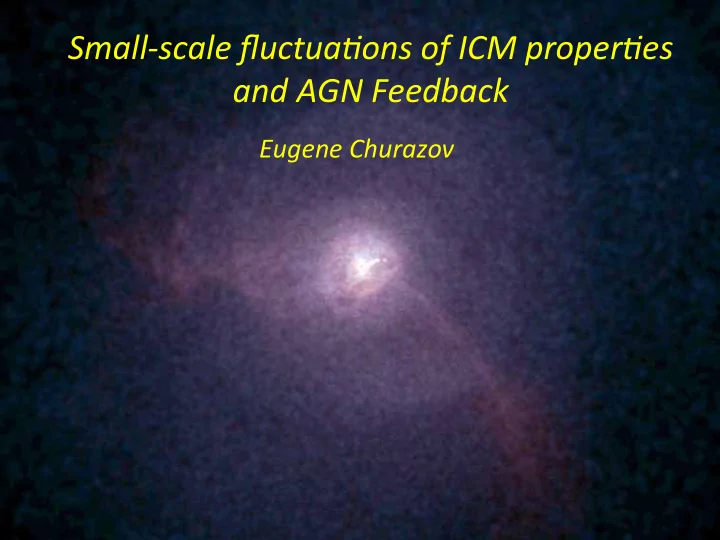

Small-scale fluctua-ons of ICM proper-es and AGN Feedback Eugene Churazov
Chandra images showing signs of AGN Feedback Jones Blanton Fabian Forman
F.E),?()>#&)>(,&),.),?()CFG) ) H?#,)D&),?()4?I&D'&).0)#''5(-./G) ) 1/)E?#,)0.5"),?()(/(5>I)#/6)"."(/,+")#5()5($(#&(6G) ) H?#,)05#'-./).0)(/(5>I)D&)6D&&D4#,(6G) ) J.(&),?()>#&)'..$G)))
Energy release options Radia-ve Mechanical Rare explosions Quasi-con-nuous Hot thermal plasma Rela-vis-c par-cles (CR) Collimated, high momentum Low momentum CR in the ICM CR confined to “bubbles” Sound waves No sound waves
K.&#,UFK1)D"#>().0),?()V(5&(+&)'$+&,(5)
C+.I#/'I)#>#D/&,);+;;$()D/*#-./) :.5)</.E/)4.E(5) – ),?()&D@().0),?();+;;$(&)D&)6(,(5"D/(6)A#$+().0) !" :.5)</.E/) ! ) – ),?()&D@().0),?();+;;$(&)D&)6(,(5"D/(6);I)4.E(5) H()'#/)"(#&+5()W(,)4.E(5)ED,?);+;;$(&) L AGN , M ! L X >> L AGN , R
2.+4$D/>),.),?()123) Z^ ! 789)&$.E$I)D/*#,(&);+;;$(&)) ) 1 ! ) E = ! ! 1 PV + PV ) g 9.)?(#-/>).0),?()123)&.)0#5_) ) `^)C+;;$(&)5D&();+.I#/,$I) ) )8+$$)#/6)9.5,?.A(5P)ab) ) =/(5>I)D&),5#/&0(55(6),.)123)6+5D/>),?()5D&() N#/6)(A(/,+#$$I)6D&&D4#,(6O) ) =/(5>I)'./&(5A#-./)$#E)XY)Z[[\)(]'D(/,) (/(5>I)(L,5#'-./)05.");+;;$(&)
:5.")789),.)123)N?(#,O)(]'D(/'I) Z[[\) F.,)V$#&"#) 3DLD/>) Z[[\) !?.'<) F.,)V$#&"#) 3DLD/>) 123) !" !.+/6) #$%" V5.4#>#-./) JD&&D4#-./) E#A(&) !" 2K)D/)123) !,5(#"D/>) >%E#A(&)c) C+;;$(&)2K) C+.I#/,)5D&() JD&&D4#-./) Z[[\) ,+5;+$(/'()
Can we generate sound waves with a spherical outburst? 1/3 ⎛ ⎞ E ⇒ R E = E t E = R E Total energy: ⎜ ⎟ ⎝ P ⎠ c s Dura-on: t b t b << t E ⇒ Sedov-Taylor phase + sound wave with 12.5% of energy t b >> t E ⇒ No shock-heated gas – 0% of energy in sound waves Upper limit on the energy of sound waves is 12.5% (spherical explosion) Tang & EC, 17 See also EC+00,01; Forman+17, Zhuravleva+16
How to test this scenario with observa-ons? 1) Test I: Measure gas veloci-es (subsonic veloci-es) 2) Test II: Measure thermodynamic proper-es of perturba-ons in the ICM (isobaric perturba-ons) 3) Test III: Es-mate dissipa-on rate (hea-ng ~ cooling?)
1/'5(#&D/>)A($.'D,I) v k ! !" k H P ! 1 ! ! c s " H s d(&,)1)e)&+;&./D')A($.'D-(&)
Gemng gas velocity power spectrum from images Zhuravleva+,14b δ I ρ ⇒ v 3 D ( k ) ⇒ δρ I ⇒ P 2 D ( k ) = C × P c s EC+, 2012; Arevalo+, 2012; Gaspari+,2014; Zhuravleva+, 2014a,b
&'()"*+,)-.)/0",/012.3+-0)1"4)5,+4",/"0()".61)"67"0()"8)1-)+-".3+-0)19" '()":,064,".6332;612<6/="%20+1)=">?@A"
Veloci-es on 60 kpc scales “line-of-sight velocity dispersion of 164±10 km/s” “gradient in the line-of-sight velocity of 150±70 km/s across the 60 kpc” 3 (164 2 + 150 2 ) ≈ 384 km/s ≈ 0.4 c s v ≈
2."4#5D&./)ED,?)!C)*+',+#-./&) @ABC@?"D4E-" F"G?HB?"DI." i?+5#A$(A#cPZn;) >?@A" >?@B" d(&,)1)e)qr)
Test II: “Equa-on of state” Isothermal δ T = 0 × δ n T n Sound waves, weak shocks δ T = 2 × δ n T 3 n Isobaric (gravity waves) δ T = − 1 × δ n T n EC+, 2016; Arevalo+, 2016; Zhuravleva+, 2016
Perseus
2345 &67)-0-89& '(&)$(*+"#,-.& &343& &:$(*+"#,-.& /0%00."$1& &;43& &:$(0-#)9&
&;43 &67)-0-89& '(&:$(0-#)9& &34?& &:$(*+"#,-.& /)<*"#<-.&=->"$1& &343& &:$(0-#)9&
E ( k ) = K 0 ! 2/3 k ! 5/3 d(&,)111e)F(#-/>)5#,() Cooling= n 2 ! ( T ) 3 k Heating = C ! V 1, k d(&,)111e)qr) i?+5#A$(A#cPZn;)
Summary In cluster cores mechanical AGN Feedback has efficiency ~100% It drives subsonic mo-ons that can offset gas cooling losses AGN radia-ve output is small In CGM mechanical AGN Feedback can have similar efficiency It may operate at low accre-on rates (no bright AGN) Does not (directly) affect the ISM but affects CGM • c 2 α M f M ( ! m ) + α R f R ( ! [ ] H = M m ) 1 α M ~1 α << R
From clusters to galaxies Churazov+,2005
Recommend
More recommend